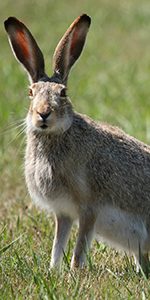| White-tailed Jackrabbit | ||
 |
Classification(s) : | Prey |
| Cat Name : | Hare | |
| Common Name : | White-tailed Jackrabbit | |
| Scientific Name : | Lepus Americanus | |
| Other Name(s) : | ||
| Physical Description : | A long, lean bodied animal with powerful hind-legs and short fore-legs. The face is small and pointed with elongated ears. The hare’s feet are broad and well furred to prevent winter frostbite and keep the animal on top of the snow. In Green-leaf the hare is a brown color, while in Leaf-bare the hare is white. During Leaf-fall and New-leaf the creature is a mottled pattern as it sheds from one coat to the next. |
|
| Physical Statistics : | Length: 7 – 10 Pounds (3 – 4.5 Kilograms) |
|
| Behavior : | This nocturnal animal is well known for grazing at dawn and dusk, favoring the cover of the night to exposing itself. All of the area hares tend to use the same paths, though they live in separate dens. |
|
| Social Organization : | Usually solitary, save one of the 2-3 annual litters a female can bear during green-leaf. |
|
| Approval Level : | Mod; Rarer than the more common Snowshoe hare, the White-tailed jackrabbit is large enough to kick and kill a grown warrior by breaking its neck. | |
| Kill Difficulty : | High; With blunt claws and a deadly kick that would break a warriors neck, the jackrabbit is dangerous enough without consider it’s size (even small ones match the size of an average warrior) and piercing teeth. |
|
| Training Level : | Specialty - Chase; Hares posses a speed and agility seen in few other species, and require a special knowledge of the art of running prey down to be hunted effectively. |
|
| Hunting Tactic : | Rabbits and Hares | |
| Food Quality : | High; The rich flesh of the hare is both nutritious and delicious. | |
